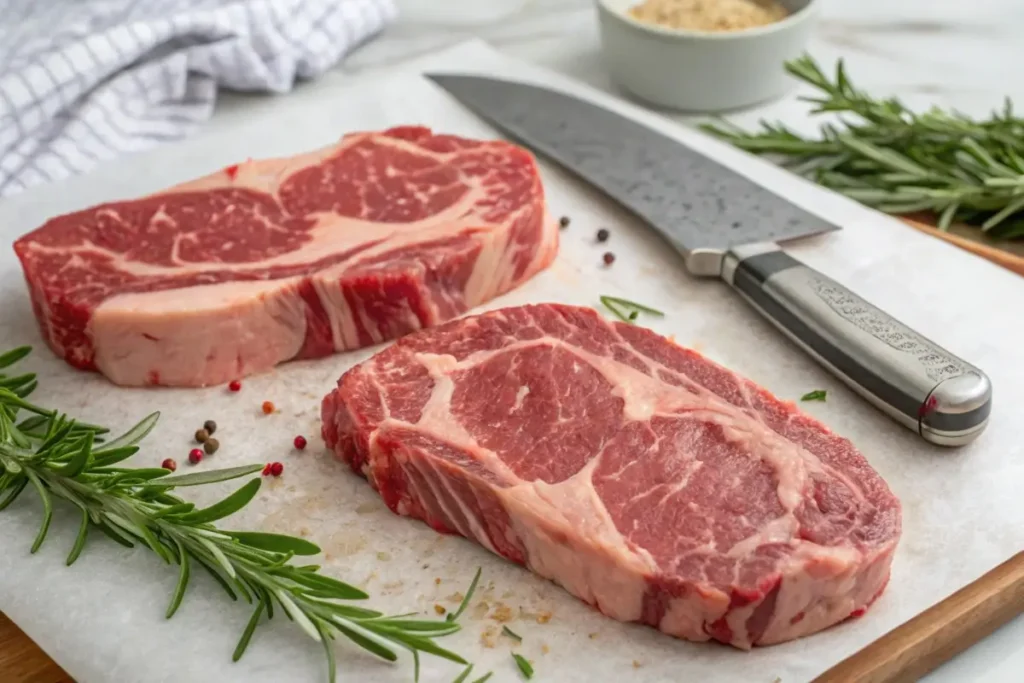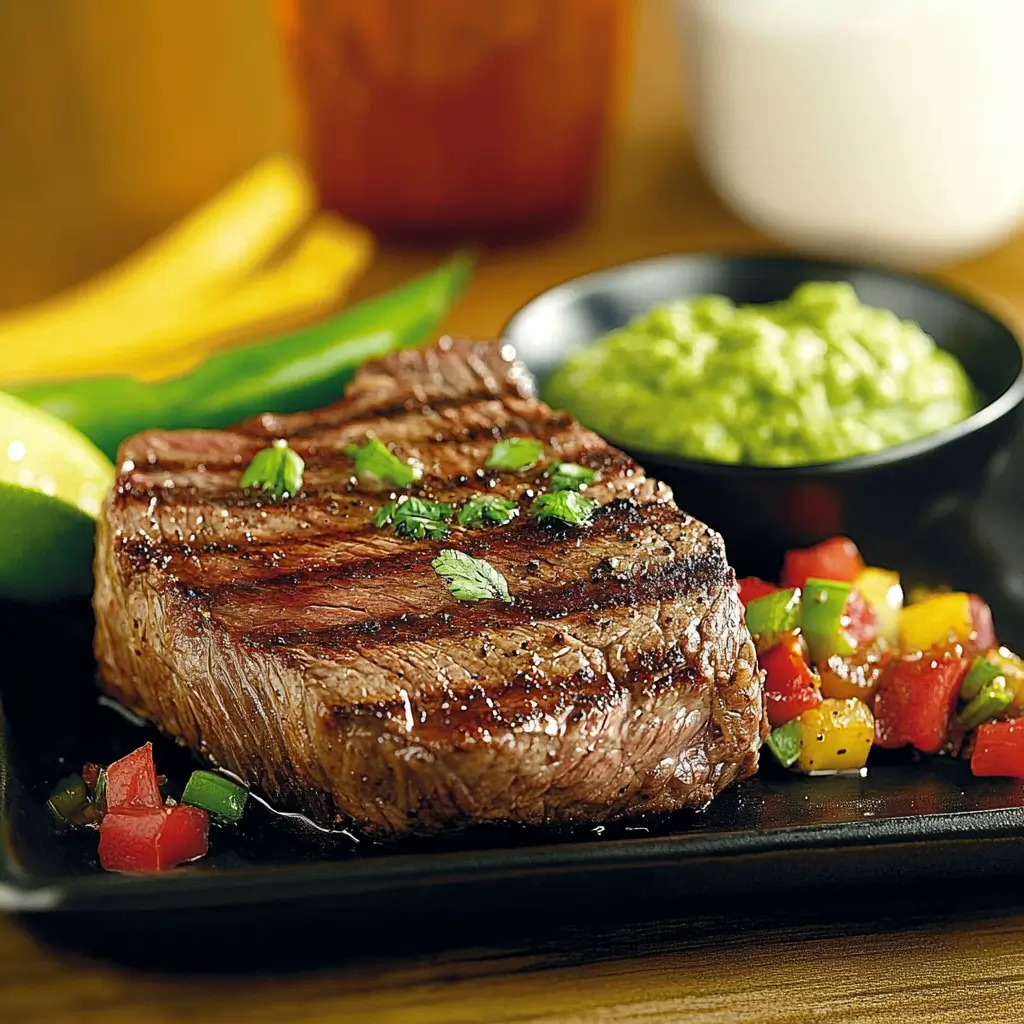Is chuck eye steak the same as Delmonico? This question often sparks curiosity among steak lovers and grill enthusiasts. While both cuts offer rich flavors and excellent texture, they are not identical. In this guide, we’ll explore their origins, characteristics, and the best ways to cook them. Whether you’re a seasoned steak connoisseur or just looking for the perfect cut for your next meal, this article will help you understand the key differences and how to prepare each steak to perfection.
Table of Contents
Understanding Chuck Eye and Delmonico Steaks
What is a Chuck Eye Steak?
The chuck eye steak is often referred to as the “poor man’s ribeye.” Why? It’s sourced from the same primal section as the ribeye, nestled in the shoulder or chuck region of the cow. This cut is known for its rich marbling, which lends it a juicy, flavorful profile similar to its pricier counterpart. However, since it comes from the shoulder, the chuck eye is slightly tougher than the ribeye, making it ideal for slow cooking or careful preparation.
This cut is limited, as only a few chuck eye steaks can be carved from each cow, making it both a hidden gem and a rare find for meat lovers.
What is a Delmonico Steak?
Ah, the Delmonico steak—a name steeped in history and a hint of mystery. Originating from Delmonico’s restaurant in New York City during the 1800s, this cut lacks a singular definition. Depending on the butcher, it could refer to a ribeye, top sirloin, or even a strip steak. What’s consistent, though, is the idea of premium quality and tenderness associated with the Delmonico name.
The Delmonico steak is usually a thicker cut with a well-marbled texture, perfect for those seeking a rich, buttery flavor.
Are Chuck Eye and Delmonico the Same?
The short answer? Not quite. While the chuck eye is sometimes marketed as a Delmonico steak, the latter’s name represents a broader category of premium cuts. Chuck eye can occasionally qualify as Delmonico depending on the butcher’s interpretation, but the two are not synonymous. This confusion stems from the variability in how Delmonico steaks are labeled and prepared.
Both cuts have distinct characteristics, so understanding their nuances helps you choose the right one for your plate.
Comparing Chuck Eye and Delmonico Steaks
Cut and Location Differences

Understanding the difference between the chuck eye steak and the Delmonico steak starts with where each cut comes from. The chuck eye, often considered the more affordable sibling of the ribeye, is cut from the cow’s shoulder (or chuck) region. Only a few chuck eye steaks are derived from each carcass, making it somewhat rare despite its lower price point.
In contrast, the Delmonico steak is not tied to a specific anatomical location. Depending on the butcher or chef, this term might refer to a ribeye, top loin, or even a sirloin cut. This variability can create confusion for consumers wondering, “Is chuck eye steak the same as Delmonico?” The answer often lies in the particular definition used in your local market.
Texture and Flavor
When it comes to texture, the chuck eye steak strikes a balance between tenderness and robustness. Its proximity to the ribeye ensures a similar fat marbling, contributing to a rich, beefy flavor. However, its slightly tougher fibers demand careful cooking to achieve maximum tenderness.
The Delmonico steak, often selected from premium cuts, is renowned for its buttery texture and luxurious flavor profile. Whether grilled, pan-seared, or broiled, the Delmonico steak offers a versatile canvas for chefs to create a high-end dining experience. Ultimately, the differences in preparation and cut impact the flavor of these steaks significantly.
Price and Availability
Cost-wise, the chuck eye is a clear winner for budget-conscious carnivores. Its affordability and flavor make it a popular choice for those seeking gourmet taste without breaking the bank. Meanwhile, the Delmonico steak, with its premium branding and often larger cut sizes, typically carries a higher price tag.
Availability is another factor to consider. Chuck eye steaks, though affordable, can be scarce because of their limited yield per animal. Delmonico steaks, due to their ambiguous definition, are more readily available but vary greatly in quality.
For more affordable steak options, check out this guide to gourmet cuts on a budget.
Cooking and Serving Tips for Both Steaks
Best Cooking Methods for Chuck Eye
The chuck eye steak shines when grilled or seared at high heat. Its marbled fat melts during cooking, imparting a mouthwatering flavor. To achieve the best results, let the steak rest at room temperature before seasoning generously with salt and pepper. Searing both sides over a hot flame locks in the juices, while finishing it in a lower heat zone ensures even cooking.
This cut also benefits from marinades that enhance its flavor and tenderness. A combination of soy sauce, garlic, and olive oil is a classic choice.
Perfecting Delmonico Steaks
Delmonico steaks are a treat for the seasoned chef. Due to their variability, cooking methods can range from broiling to pan-searing. For the most common ribeye-based Delmonico, a hot cast-iron skillet is your best friend. Start by preheating the skillet, adding a touch of butter, and searing the steak until a crust forms.
To elevate the dish, pair the Delmonico with a robust red wine reduction or herb butter. Complementing the steak with roasted vegetables or a creamy mashed potato side makes it a meal worthy of a fine dining experience.
Common Mistakes to Avoid
Avoid overcooking either steak, as this can lead to a chewy, less flavorful experience. For chuck eye, be wary of skipping the resting period before cutting, as this helps retain juices. For Delmonico steaks, improper seasoning or uneven cooking can compromise the experience.
Want to explore side dishes that pair beautifully with these steaks? Visit this curated list of steak pairings for ideas.
Nutritional and Culinary Considerations
Nutritional Profiles
When comparing the chuck eye steak and Delmonico steak, their nutritional profiles reveal subtle differences. Both cuts are rich in protein, essential for muscle growth and repair. On average, a 4-ounce serving of chuck eye steak provides around 25 grams of protein, while a Delmonico steak offers slightly more, depending on the specific cut.
Fat content varies between the two as well. Chuck eye steaks contain more fat due to their robust marbling, unlike the leaner Delmonico steaks that come from cuts like the top sirloin. However, this extra fat contributes to the rich flavor that makes the chuck eye so appealing.
Both steaks are excellent sources of iron and B vitamins, essential nutrients for energy production and overall health. However, it’s essential to balance portion sizes with other food groups to maintain a well-rounded diet.
Pairing with Side Dishes
Pairing your steak with the right side dishes can elevate your meal. Chuck eye steaks, with their hearty flavor, go well with bold sides like roasted garlic potatoes or smoky grilled vegetables. Meanwhile, the Delmonico steak pairs beautifully with lighter, elegant sides like a refreshing arugula salad or creamy risotto.
Frequently Asked Questions
Why is Chuck Eye Called the “Poor Man’s Ribeye”?
The chuck eye steak is often called the “poor man’s ribeye” due to its location on the cow. Cut just adjacent to the ribeye section, it shares many of the same characteristics—rich marbling and intense flavor—at a fraction of the cost. This makes it a popular choice for steak lovers on a budget.
How Can I Identify a Delmonico Steak in the Store?
Identifying a Delmonico steak can be tricky since the term doesn’t refer to a single cut. Typically, butchers label ribeye, top sirloin, or strip steaks as Delmonico. Look for thick cuts with good marbling to ensure a premium choice. Always ask your butcher if you’re unsure about the cut.
Is Chuck Eye Steak the Same as Delmonico?
While these two cuts are sometimes marketed interchangeably, the answer to “Is chuck eye steak the same as Delmonico?” depends on the butcher’s interpretation. Chuck eye comes from the shoulder, while Delmonico refers to premium cuts from various parts of the cow. Knowing the origin of each cut can help you make informed choices.
What’s the Best Way to Cook a Chuck Eye Steak?
For the best chuck eye steak experience, high-heat methods like grilling or pan-searing work wonders. Rest the steak before cutting to preserve its juices. Using marinades or rubs with garlic, rosemary, or smoked paprika can enhance its natural flavor.
With these detailed comparisons, nutritional insights, and cooking tips, you can confidently choose and prepare the perfect steak for your next meal!
Choosing the Right Steak for You
Factors to Consider When Choosing Between Chuck Eye and Delmonico
When deciding between a chuck eye steak and a Delmonico steak, your choice will largely depend on personal preferences and the occasion. If you’re looking for a flavorful yet affordable option, the chuck eye is a standout choice. It’s an excellent cut for casual grilling or weeknight meals when you want a rich, beefy taste without stretching your budget.
On the other hand, if you’re hosting a special dinner or craving a luxurious dining experience, the Delmonico steak is hard to beat. Known for its tenderness and high-quality cuts, it pairs wonderfully with gourmet accompaniments.
Matching Your Steak to the Cooking Method
Another crucial factor is the cooking method you plan to use. The chuck eye steak excels in high-heat cooking methods like grilling or broiling, where its marbling melts to enhance flavor. In contrast, the Delmonico steak is more versatile, lending itself well to grilling, pan-searing, or even oven-roasting, depending on the cut used.
Still wondering, Is chuck eye steak the same as Delmonico? While they share some similarities, knowing your culinary goals can help you choose the right one for your meal.
The Final Verdict on Chuck Eye vs. Delmonico
Are These Steaks Interchangeable?
The big question remains: Is chuck eye steak the same as Delmonico? The answer lies in understanding their distinctions. Some butchers occasionally label the chuck eye as Delmonico because of its ribeye-like qualities, but true Delmonico steaks belong to a broader category of premium cuts. The overlap can be confusing, but their differences in texture, flavor, and origin make each cut unique.
For everyday meals, the chuck eye offers exceptional value and flavor. Its affordability and close resemblance to ribeye make it a favorite among steak enthusiasts seeking high quality on a budget. However, the Delmonico steak stands apart as a luxurious option for those seeking an elevated dining experience.
Final Thoughts on Choosing Between These Cuts
Choosing between chuck eye and Delmonico steaks ultimately comes down to budget, occasion, and taste preferences. The chuck eye is perfect for hearty, satisfying meals that don’t break the bank. Meanwhile, the Delmonico steak, with its premium quality and variability, is ideal for impressing guests or treating yourself to a gourmet meal.
Regardless of your choice, both cuts shine when paired with thoughtful preparation and complementary sides. Whether you’re grilling for friends or crafting a fine dining masterpiece, either steak can elevate your meal with proper care.
For more tips on steak preparation and side pairings, explore other recipes and guides on your favorite culinary sites. By understanding these cuts fully, you’ll confidently answer the question, Is chuck eye steak the same as Delmonico? and prepare a meal worthy of any occasion.
Common Misconceptions About Chuck Eye and Delmonico Steaks
Mislabeling in the Market
One of the biggest reasons people ask, “Is chuck eye steak the same as Delmonico?” is due to mislabeling at grocery stores and butcher shops. Butchers and chefs often use the term “Delmonico steak” loosely to describe various cuts, creating confusion. Some markets occasionally brand the chuck eye steak as a Delmonico, but the two cuts are not always the same. This inconsistency can lead to surprises when it comes to texture and flavor.
To avoid disappointment, always ask your butcher about the specific cut when purchasing a Delmonico steak. Understanding the origin of the steak helps you choose one that matches your expectations.
Flavor vs. Cost Assumptions
Another common myth is that all Delmonico steaks are superior to chuck eye steaks. While Delmonico steaks are often pricier and considered more luxurious, the chuck eye can deliver comparable flavor, especially when cooked properly. Its affordability makes it a hidden gem for steak enthusiasts who want rich taste without the hefty price tag.
Breaking down these misconceptions can help you make more informed choices when shopping for or preparing these cuts.
Expert Tips for Buying and Cooking the Perfect Steak
How to Select the Best Chuck Eye and Delmonico Steaks
Selecting the best steak starts with inspecting the meat. For a chuck eye steak, look for even marbling and a deep red color, which indicate freshness and flavor. Keep in mind that this cut is limited, so availability may vary depending on your location.
When choosing a Delmonico steak, focus on the specific cut labeled as such. Whether it’s a ribeye or a sirloin, prioritize steaks with visible marbling and uniform thickness to ensure even cooking.Always ask for guidance if you’re unsure about which cut the butcher is marketing as Delmonico.
Cooking Secrets for Maximum Flavor
The key to cooking either steak lies in proper preparation. For the chuck eye steak, marinate it overnight to enhance tenderness and flavor. High-heat methods like grilling or broiling help bring out its rich, beefy taste. Don’t forget to let it rest for at least five minutes after cooking to retain its juices.
For a Delmonico steak, seasoning with just salt and pepper allows the natural flavors to shine. Searing it in a hot cast-iron skillet creates a beautiful crust, while finishing in the oven ensures an even, tender cook. Pairing it with garlic butter or a red wine reduction takes the experience to another level.
To explore more steak recipes and techniques, check out resources on your favorite recipe websites. Understanding these tips ensures you can confidently address questions like “Is chuck eye steak the same as Delmonico?” while impressing your guests with a perfectly cooked meal.
Conclusion:
So, is chuck eye steak the same as Delmonico? The answer isn’t as straightforward as you might hope. While the two cuts share some similarities, such as rich flavor and occasional overlapping usage in labeling, they are distinct in origin, texture, and price. The chuck eye offers a budget-friendly option with a hearty flavor, earning it the nickname “poor man’s ribeye.” Meanwhile, the Delmonico steak represents a class of premium cuts, offering tenderness and versatility for more upscale dining.
When choosing between the two, let your budget, taste preferences, and cooking method guide you. Both cuts can shine with the right preparation, making them excellent options for different occasions. By understanding these steaks’ unique qualities, you can shop with confidence and craft meals that impress.
Whether you’re grilling for a casual barbecue or creating a gourmet dinner, you now have the knowledge to make the perfect choice. Remember, the magic lies not just in the cut but in how you prepare and savor it. Enjoy your steak adventure!

